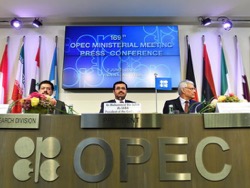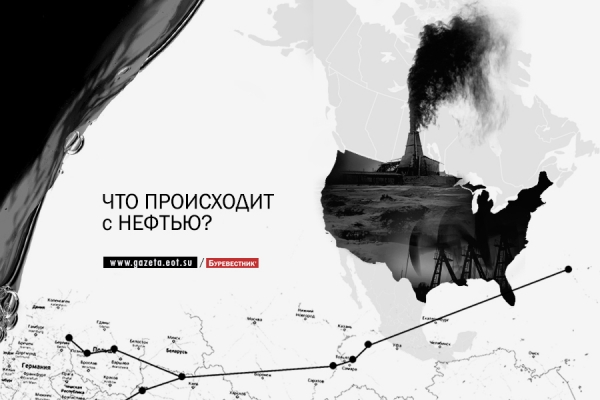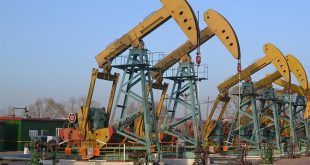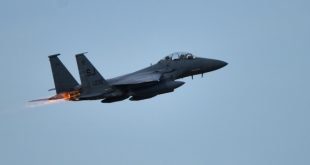
The next, already the third this year an unsuccessful attempt of the countries-participants of OPEC to agree on the freezing of oil production was the signal for the retreat of world prices for “black gold”.
3 June, the cost of the August futures for Brent crude on the London ICE Futures exchange to 15:00 Moscow time have fallen by about 0.5%, to $ 49,8 per barrel. While we are talking about a small correction. That confirms the assumption — none of the big players have no illusions about the results of the meeting in Vienna, which took place the day before. Continued dumping rally foreshadowed by the statistics: in April, the OPEC States has increased production to 188 thousand barrels per day, up to 32.44 million
As a result, even the failure of the shale projects in the United States could not compensate for the excess fuel on the world market, amounting to 2-2. 5 million b/d. as the chief culprit of the failure of negotiations experts point to Iran, which continues to increase production after the lifting of sanctions. In an effort to prevent churn of customers to its main geopolitical rival, Iran is forced to “help” Riyadh (Saudi Arabia) and Doha (Qatar).
In this situation, even a drop in the volumes of hydrocarbon export from Nigeria and Canada does not allow you to plug the “gusher”. The radical group “Avengers of the Niger Delta”, committing acts of sabotage against the infrastructure of the Western mining companies, threatening to bring “oil production in Nigeria to zero”. As for Canada, the decline of the export potential here is purely economic background. Heavy oil extracted from tar Sands, is simply not competitive on the world market in the current price environment.
Anyway, the stabilization of oil prices, which OPEC has postponed the idea of freezing production, is deceptive. Because supply disruptions from Nigeria and Canada, apparently, temporary.
The main beneficiaries of the oil sales, arranged by-exporting countries (including Russia) in the struggle for survival on the market skukozhivaetsya, are developed countries. First and foremost, members of the EU, the US and China, which seek to support economic growth and the level of consumption in conditions of global crisis.
As expected the currencies of the countries, got hooked on the “raw needle”, the ruble was quick to react on the price rebound in the market of hydrocarbons. On Friday in the framework of the unified trading session on the Moscow stock exchange the dollar exchange rate as at 15:00 GMT against the ruble rose by 15 cents (67,11 RUB/$ 1), Euro gained 11 cents (74,79 RUB./EUR1). However, by evening, the “American” again subsided, but it happened after the publication of data on the US economy.
Recall that in late may, the market began to stabilize. The price of Brent crude oil for the first time since November 4, 2015 back to the psychological mark of $ 50 per barrel.
Member of the expert Council of the Union of oil and gas producers of Russia Eldar Kasaev notes that the process of pricing in the oil industry is influenced by two factors — the macroeconomic and speculative.
— With regard to macroeconomics, is the level of supply and demand. In addition to disruptions in the supply of hydrocarbons from Canada and Nigeria, there is stagnation in the production of American shale oil. The peak of its production in the U.S. was reached in April-may last year. And in April of this year was extracted by about 700 thousand barrels per day less. This is half of the existing excess of supply over demand, which is estimated at 1.5 trillion “barrels” per day. The plunge significantly, given that Americans have always excited the market.
“SP”: — the Number of drilling rigs in the U.S. has steadily decreased over the past year, if not more. However, a significant price rebound (up to $ 50 a barrel) was recorded only at the end of may. What is the reason?
— The number of drilling has declined, but production remained high. Because, in the first place, froze those deposits that were developed for the future. And those who make a profit here and now, continued to work. In 2016 g. about 60 companies in the US filed for bankruptcy. Of course, when prices rise, production revived, but until that happens. In summary, the oil became less, prices began to rise.
A certain role was played by the speculative factor that is associated with the fact that market participants expect the decisions of the countries-exporters of freezing of oil production at the meetings of their representatives in OPEC. Thus, despite the fall in the value of “black gold”, the volume of its production continued to grow. Incidentally, Russia is one of the countries that is well earned on this.
“SP”: — Then why Moscow supports the initiative to fix the production at the current level?
The problem is that we are in April were at their best. Even if Russian companies have frozen oil production at current levels, they would have achieved those figures that were planned for 2016 However, after the April fiasco at a meeting in Doha, it became clear that to heat up the market among the optimistic statements, if they are not carried out, will not work.
In my opinion, the “Trojan horse” more will make themselves known. Remember in 2015, when the beginning of the year to may, prices increased considerably, and with the onset of summer once again began to fall.
“SP”: — What accounts for these fluctuations?
— The reasons are different. One of them — the dynamics of growth of the Chinese economy. At first, the players in the market focused on the slowing. Then it became clear that China, by contrast, buys and consumes energy more than before. This is due to their cheapness. For example, in the first quarter of this year, oil supplies to China increased by 15%.
“SP”: — If industrial production is slowing down, why China so much oil? He overstock for the future?
— Of course. It is simple — the liquid hydrocarbons is pumped into storage tanks.
In my opinion, macroeconomic indicators in the world gradually coming back to normal. Probably until the end of the year the growth of prices for oil we will not see. But in 2017 they will be fixed at $ 50-55 per barrel. Since the beginning of the fall (summer 2014) and today investment in oil production has decreased dramatically. Such a large supply in the market will be gone and demand will remain at the same level (perhaps even grow). So the scissors of supply and demand, which now diverge in the medium term will merge. And we will see stabilization in the market.
“SP”: — At the end of execution of the Federal budget in January-February 2016 the share of oil revenues in total revenues amounted to only 37.4 per cent (the lowest since 2009). So, Russia, albeit with the inevitable in such a situation cost, but gets rid of raw dependence?
— There is hardly a shortage of “petrodollars” that could have been spent to stimulate the economy in terms of sanctions can be seen as a positive thing. The so-called commodity curse is a myth. The level of oil production, the United States consistently among the three leaders (together with Russia and Saudi Arabia), periodically bursting in the first place. However, this does not prevent them to have a highly diversified economy.
Naturally, falling prices for “black gold” for the Russian economy gets much stronger as other countries with the same raw structural imbalance. However, for us it is not critical. As I understand it, the government prepared for the fact that the price per barrel will cost two times less than planned in the budget (i.e., $ 25 per barrel instead of the current $ 50).
“SP”: — at the beginning of the year, such a scenario seemed almost apocalyptic…
— It is not necessary to exaggerate. The cost of oil production we have one of the lowest in the world (along with Saudi Arabia and Iran). So the industry can survive and at a very hard price situation. Incidentally, in the history of post-Soviet Russia there were periods when the barrel cost was incomparably less, but the country lived, albeit not without problems. Paramilitary time, actually, to show off will not work. The Iranians who had been under Western sanctions for several decades, is well aware of.
But before the complete destruction of the economy as in Ukraine, we, of course, far. Even $ 30 per barrel will be enough to tide us over. I think by the end of the year in the negotiation process involving major oil exporters, there will be serious progress. Even the leader of OPEC — Saudi Arabia, is experiencing severe discomfort.
“SP”: — Maybe due to the stated policy of import substitution, Russia should get out of dumping “race to the bottom”. And instead of trying to pump the market with cheap energy in favour of the highly developed competitors, engaged in the recycling of hydrocarbons.
— I absolutely agree, it’s time to switch to refining. Engine of economic growth the raw material has not become, unlike the petrochemical industry. It needs to invest the available funds in the modernization of existing enterprises and construction of new facilities. The process is not quick start it should have been yesterday: we were late by 10-15 years. But as they say, better late than never. In this respect, we have a good example in the face of China, where the petrochemical products is very high as a share of GDP, in contrast to Russia.
The General Director of national energy Institute Sergei Pravosudov shared the view that the growth in oil consumption in the world is directly connected with its low cost.
Is the underlying factor, which explains a lot. On the other hand, equally important is the reduction of production in the United States. As for OPEC, they will, with low manufacturing costs, don’t want to lose competition to the us “kancevica” or producers in the North sea.
Plus the consensus on freezing the production of interfere with purely political considerations. It is no secret that between Saudi Arabia and Iran there are significant differences. In fact, these countries are “hybrid war” in Yemen, Syria and Iraq. I don’t think in this situation, Riyadh and Tehran are able to negotiate.
In the future, will result in the displacement of high oil prices in the growth of consumption. A lot depends on how to grow production in the middle East. This is the main unknown in the price equation. If the manufacture will cover the decline in the USA, then the oil will remain on the same low level.
“SP”: — Many experts have voiced doubt that Iran out from under sanctions, will be able to quickly increase production.
— Actually no one knows by what means this was achieved. I do not exclude that this is due to the stocks in tankers and storage tanks. Perhaps the Iranians in the sanctions period were “grey” production, and now she came out from the shadows. Foreign companies in Iran do not work, so everything is very conditional. One way or another, Tehran has increased the supply on the world market.
“SP”: — what is the intention of the Saudis to sell a large stake in the national company, Saudi Aramko? Financial hunger makes you cut the “cash cow”?
— It is a state monopoly, which accounts for 10% of world production. I understand that Riyadh is ready to part with a minority stake. Politics and Economics in this decision are interrelated. Due to the fall in oil prices, Saudi Arabia has received the budget deficit. In the result, the authorities are forced to sell assets (including US treasuries), to get into financial reserves. The second point is a hard confrontation with the United States due to the fact that Washington was to flirt with the implacable enemy of Riyadh, in the face of Tehran. In turn, American politicians increasingly allow themselves unfriendly gestures towards Saudi Arabia itself. For example, almost openly accused the Saudis of the September 11 tragedy. The last fear that the U.S. government will use the courts to arrest their property.
Accordingly, Riyadh need new partners, another force, which could rely in conflict with the same Iran. Think for sale package Saudi Aramko buy Chinese. Hardly Russian companies have disposable funds to buy even a small stake in the Saudi giant oil reserves which are estimated at $ 319 billion (second largest in the world). Plus the infrastructure for extraction and transport. According to preliminary estimates, in the primary location Saudi Aramko can be estimated at $ 2.5 trillion. Most likely, the Saudis, in the end, will make a discount on the basis of political considerations.
“SP”: — OPEC Representatives have chosen a new CEO of the organization. How might this affect the course of further negotiations on the freezing of the production level?
— I do not think that the arrival of the post is Nigerian Mohammed Barkindo, who previously headed the state oil company of Nigeria, will change the policy of the cartel. Yes, Nigeria supports the idea to fix the extraction on the current bar, but it’s absolutely nothing. OPEC Ministers are not empowered to make decisions, they are just voicing them.
“SP”: — In General, from the point of view of the problem of the budget deficit, the oil industry does not give the Russians cause for optimism?
In this respect, things are not so simple. The price of oil in dollars fell, but it kompensiruet devaluation of the ruble. I will remind, in the budget for the current year laid the ruble price of oil at $ 3165 per barrel. In may, the figure for the first time in 2016 exceeded this figure. So I see no reasons for alarmist sentiments.







